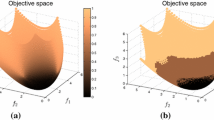Abstract
The search for the best trade-off solutions with respect to several criteria (also called the Pareto set) is the main approach pursued in multi-objective optimization when no additional preferences are associated to the objectives. This problem is known to be compliant with the maximization of the hypervolume (or S-metric), consisting in the Lebesgue measure of the dominated region covered by a set of solutions in the objective space, and bounded by a reference point. While several variants of population-based metaheuristics like evolutionary algorithms address formulations maximizing the hypervolume, the use of gradient-based algorithms for this task has been largely neglected in the literature. Therefore, this paper proposes to solve bi-objective problems by hypervolume maximization through a sequential quadratic programming algorithm. After theoretical developments including the analytical expression of the sensitivities of the hypervolume expressed as functions of the gradient of the objectives, the method is applied to six benchmark test cases, demonstrating the efficiency of the proposed method in comparison with a scalarization of the objectives, and with a state-of-the-art multi-objective genetic algorithm. This method is believed to provide an interesting alternative to metaheuristics when the gradients of the objective functions are available at a limited additional cost, a situation which is encountered in versatile applications, for instance with adjoint methods implemented in computational solid mechanics or fluid dynamics.





Similar content being viewed by others
References
Assis, L.P., Maravilha, A.L., Vivas, A., Campelo, F., Ramírez, J.A.: Multiobjective vehicle routing problem with fixed delivery and optional collections. Optim. Lett. 7(7), 1419–1431 (2013)
Auger, A., Bader, J., Brockhoff, D., Zitzler, E.: Investigating and exploiting the bias of the weighted hypervolume to articulate user preferences. In: Genetic and Evolutionary Computation Conference (GECCO 2009), Montreal, Canada, July 8–12, vol. 2632, pp. 519–533 (2009)
Auger, A., Bader, J., Brockhoff, D., Zitzler, E.: Hypervolume-based multiobjective optimization: theoretical foundations and practical implications. Theor. Comput. Sci. 425, 75–103 (2012)
Beume, N., Naujoks, B., Emmerich, M.: SMS-EMOA: multiobjective selection based on dominated hypervolume. Eur. J. Oper. Res. 181(3), 1653–1669 (2007)
Bringmann, K., Friedrich, T.: Approximating the least hypervolume contributor: NP-hard in general, but fast in practice. Theor. Comput. Sci. 425, 104–116 (2012)
Brockhoff, D., Friedrich, T., Neumann, F.: Analyzing hypervolume indicator based algorithms. In: Parallel Problem Solving from Nature—PPSN X, pp. 651–660 (2008)
Chen, X.S., Ong, Y.S., Lim, M.H., Tan, K.C.: A multi-facet survey on memetic computation. IEEE T Evolut. Comput. 15(5), 591–607 (2011)
Coello Coello, C.A., Van Veldhuizen, D.A., Lamont, G.B.: Evolutionary Algorithms for Solving Multi-Objective Problems. Kluwer Academic/Plenum Publishers, New York (2002)
Deb, K.: Constrained test problems for multi-objective evolutionary optimization. In: Zitzler, E., Deb, K., Thiele, L., Coello Coello, C.A., Corne, D. (eds.) First International Conference on Evolutionary Multi-Criterion Optimization, EMO 2001, pp. 284–298. Springer, Zurich (2001)
Deb, K., Pratap, A., Agarwal, S., Meyarivan, T.: A fast and elitist multiobjective genetic algorithm: NSGA-II. IEEE T Evolut. Comput. 6(2), 182–197 (2002)
Descamps, B., Filomeno Coelho, R.: A lower-bound formulation for the geometry and topology optimization of truss structures under multiple loading. Struct. Multidiscip. O 48(1), 49–58 (2013)
Emmerich, M., Deutz, A., Beume, N.: Gradient-based/evolutionary relay hybrid for computing Pareto front approximations maximizing the S-metric. In: Proceedings of the 4th International Conference on Hybrid Metaheuristics, Dortmund, Germany, October 8–9, pp. 140–156 (2007)
Fleischer, M.: The measure of Pareto optima. Applications to multi-objective metaheuristics. In: Fonseca, C.M., Fleming, P.J., Zitzler, E., Thiele, L., Deb, K. (eds.) Evolutionary Multi-Criterion Optimization, LNCS, vol. 2632, pp. 519–533. Springer (2003)
Fliege, J., Svaiter, B.F.: Steepest descent methods for multicriteria optimization. Math. Methods Oper. Res. 51, 479–494 (2000)
Graña Drummond, L.M., Svaiter, B.F.: A steepest descent method for vector optimization. J. Comput. Appl. Math. 175, 395–414 (2005)
Pardalos, P.M., Steponavičė, I., Z̆ilinskas, A.: Pareto set approximation by the method of adjustable weights and successive lexicographic goal programming. Optim. Lett. 6(4), 665–678 (2012)
Z̆ilinskas, A.: A one-step worst-case optimal algorithm for bi-objective univariate optimization. Optim. Lett. (2013). Published online
Wright, S., Nocedal, J.: Numerical Optimization. Springer, New York (1999)
Zhou, A., Qu, B.Y., Li, H., Zhao, S.Z., Suganthan, P.N., Zhang, Q.: Multiobjective evolutionary algorithms: a survey of the state of the art. Swarm Evolut. Comput. 1, 32–49 (2011)
Zitzler, E., Thiele, L., Laumanns, M., Fonseca, C.M.: Performance assessment of multiobjective optimizers: an analysis and review. IEEE T Evolut. Comput. 7(2), 117–132 (2003)
Acknowledgments
This work has been supported by Innoviris (Brussels-Capital Region, Belgium) under a BB2B project entitled “Multicriteria optimization with uncertainty quantification applied to the building industry”.
Author information
Authors and Affiliations
Corresponding author
Appendix: definition of the six test cases
Appendix: definition of the six test cases
Rights and permissions
About this article
Cite this article
Filomeno Coelho, R. Bi-objective hypervolume-based Pareto optimization. Optim Lett 9, 1091–1103 (2015). https://doi.org/10.1007/s11590-014-0786-y
Received:
Accepted:
Published:
Issue Date:
DOI: https://doi.org/10.1007/s11590-014-0786-y




